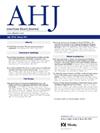Medicare coverage gap status, adherence to oral anticoagulation, and stroke rates in patients with atrial fibrillation
IF 3.5
2区 医学
Q1 CARDIAC & CARDIOVASCULAR SYSTEMS
引用次数: 0
Abstract
Background
Prior to 2025, Medicare Part D included a coverage gap during which beneficiaries were responsible for substantially higher portions of medication costs. The impact of this on oral anticoagulant (OAC) prescription fills and subsequent stroke in patients with atrial fibrillation (AF) is not known.
Methods
Using Centers for Medicare and Medicaid Services claims data from 2016 to 2018, we evaluated OAC prescription fills in patients with AF by assessing their proportion of days covered on OAC before, during, and after their coverage gap. Hazard of stroke was assessed for patients who entered the coverage gap before entering, while in, and after exiting, the gap.
Results
Patients who entered the coverage gap had a 16% decrease in median proportion of days covered from pregap (0.92 [interquartile range 0.80, 0.97]) to in-gap (0.76 [0.41, 0.98]). Proportion of days covered continued to drop for patients who entered and then left the coverage gap, despite regaining coverage (pregap: 0.95 [0.85, 0.98]; in-gap: 0.88 [0.55, 0.97]; postgap: 0.70 [0.00, 1.00]). Patients who entered the gap were at significantly higher risk for stroke while in the gap (HR 2.21, 95% CI 1.91-2.54) and during the combined in-gap and postgap periods (HR 3.13, 95% CI 2.71-3.62).
Conclusions
OAC use decreased upon entering the coverage gap and was associated with an increased stroke risk, that persisted for the rest of the calendar year. Health policy decisions regarding Medicare can have unintended adverse public health consequences, highlighting the importance of assessing the impact of such policy changes.
房颤患者的医疗保险覆盖缺口状况、口服抗凝药物依从性和卒中发生率。
背景:在2025年之前,医疗保险D部分包括一个覆盖缺口,在此期间,受益人承担的药物费用要高得多。这对房颤(AF)患者口服抗凝剂(OAC)处方填充和随后卒中的影响尚不清楚。方法:使用医疗保险和医疗补助服务中心2016-2018年的索赔数据,我们通过评估AF患者在覆盖缺口之前、期间和之后的OAC覆盖天数比例来评估他们的OAC处方填写情况。对在进入覆盖缺口前、进入覆盖缺口时和离开覆盖缺口后进入覆盖缺口的患者进行卒中风险评估。结果:进入覆盖缺口的患者从缺口前(0.92[四分位数间距0.80,0.97])到缺口内(0.76[0.41,0.98])的覆盖天数中位数比例减少了16%。尽管重新获得了覆盖,但进入然后离开覆盖缺口的患者的覆盖天数比例继续下降(缺口前:0.95 [0.85,0.98];间隙:0.88 [0.55,0.97];后间隙:0.70[0.00,1.00])。进入空当期的患者在空当期(HR 2.21, 95% CI 1.91-2.54)以及空当期和空当期后合并(HR 3.13, 95% CI 2.71-3.62)卒中风险明显较高。结论:OAC的使用在进入覆盖缺口后减少,并与卒中风险增加相关,这种情况在日历年的剩余时间内持续存在。关于医疗保险的卫生政策决定可能产生意想不到的不利公共卫生后果,这突出了评估此类政策变化影响的重要性。
本文章由计算机程序翻译,如有差异,请以英文原文为准。
求助全文
约1分钟内获得全文
求助全文
来源期刊

American heart journal
医学-心血管系统
CiteScore
8.20
自引率
2.10%
发文量
214
审稿时长
38 days
期刊介绍:
The American Heart Journal will consider for publication suitable articles on topics pertaining to the broad discipline of cardiovascular disease. Our goal is to provide the reader primary investigation, scholarly review, and opinion concerning the practice of cardiovascular medicine. We especially encourage submission of 3 types of reports that are not frequently seen in cardiovascular journals: negative clinical studies, reports on study designs, and studies involving the organization of medical care. The Journal does not accept individual case reports or original articles involving bench laboratory or animal research.
 求助内容:
求助内容: 应助结果提醒方式:
应助结果提醒方式:


